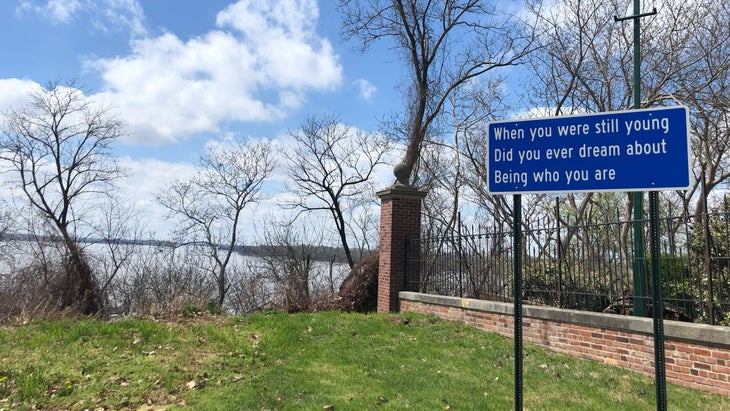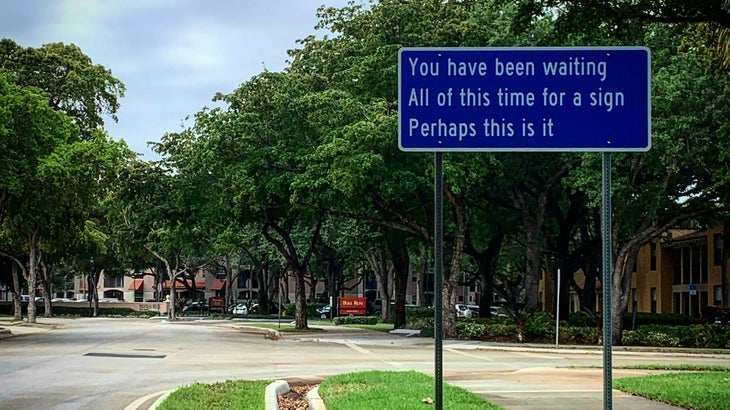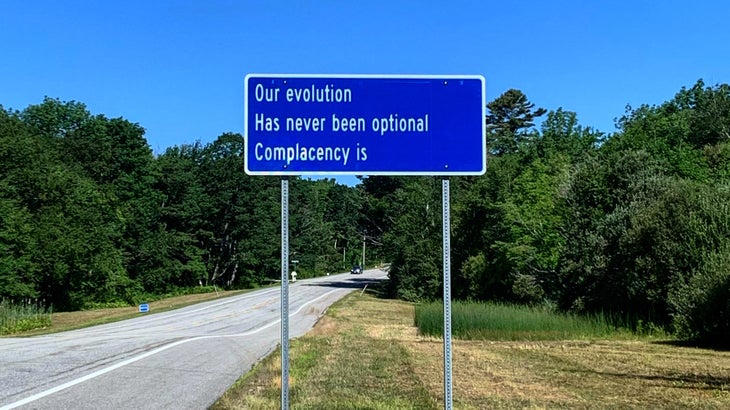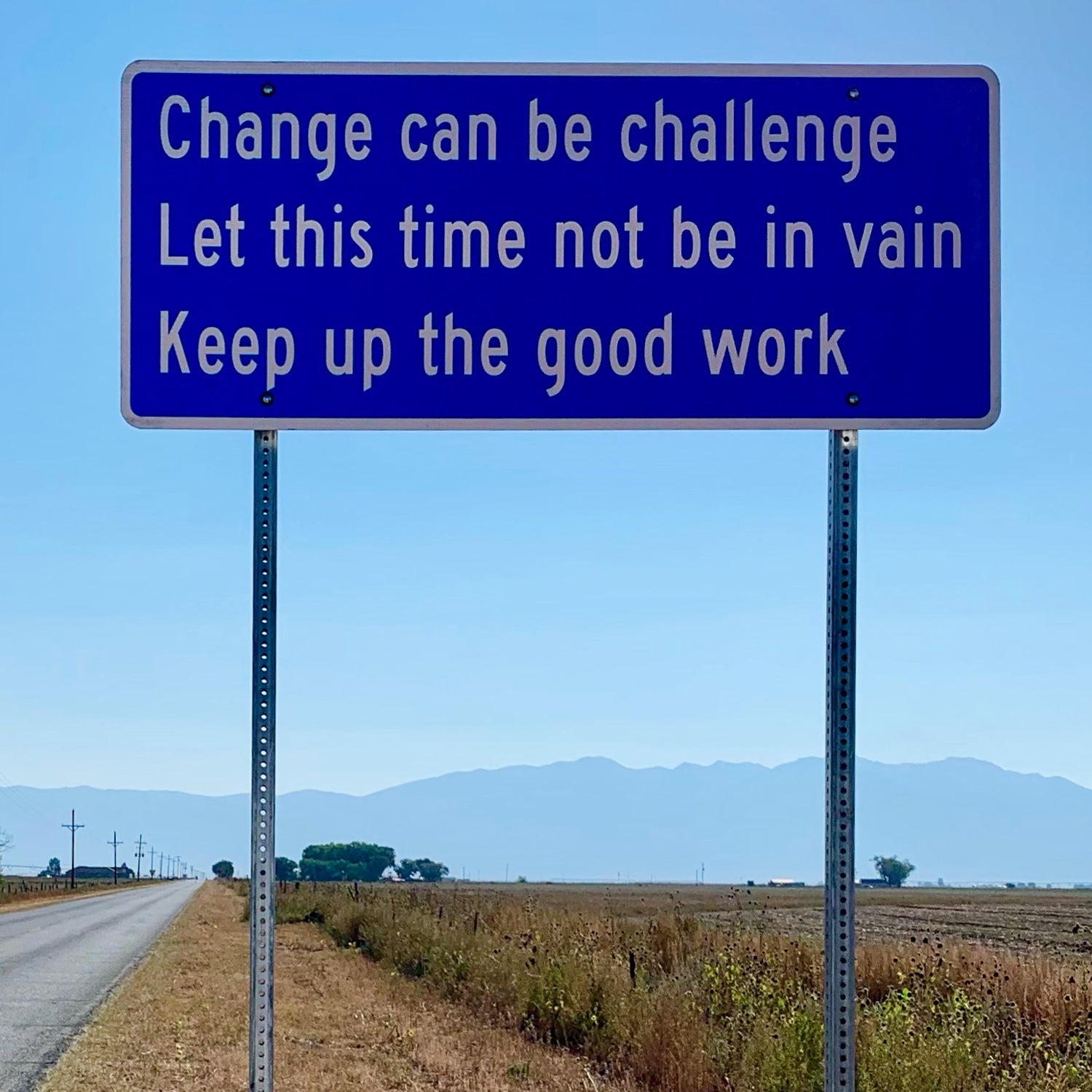Linda Wingerter was very familiar with the two-lane stretch of highway in Ulysses, New York. For a time, she and her husband traveled it most Sundays to visit friends. Those trips stopped in early 2020 as the pandemic unfolded, but by July they’d resolved to try again. Yet on one of those early summer trips, their car cruised by something peculiar.
“Just as we were driving past it, it caught my eye,” Wingerter said. “I was like, wait a minute, that was a poem.’” Except the words appeared on a large rectangular road sign—standard-issue cobalt blue, with a white border and white lettering, the kind that might point toward a rest area or share tourist information.
Wingerter didn’t have time to make out the lines, and for the two-hour visit on their friend’s porch, the intrigue nagged like an itch. “Somewhere, I swear to God there’s a poem,” she told her husband when they got back into the car. “We have to find it.”
They drove until she finally spotted it. The sign read:
Where is my person
I ask forgetting that I
Am standing right here
“We’d been isolated up until then,” she said, “and seeing that just meant everything to me. It was this moment of magic and somebody caring about this spot on a road, which is meaningless, really—just a bunch of woods. It just felt like human contact in a way that hadn’t happened in so long.”
Wingerter, a puppeteer who also works at the Cornell University Library, had moved to upstate New York a year and a half earlier with her husband, leaving family and friends in Connecticut. She was still feeling uprooted when the pandemic hit, and then that spring, her husband’s father died of COVID. “It was a really hard time,” she told me. Nearly two years later, she continues to think about the sign and is still full of questions: Who? How? Why?

Around that same time, a thousand miles away, in Memphis, Tennessee, I’d also driven by a sign that was asking a question way above its pay grade:
When you were still young
Did you ever dream about
Being who you are
It was jarring, and the feeling lingered.
It turns out, the two signs were among 23 that appeared across the country between June 2020 and December 2021. They sprouted along urban thoroughfares and dusty backroads from coastal Maine to the California desert and south into Texas, not far from the U.S.-Mexico border. A sticker on the back with a web address is the lone breadcrumb leading to the person behind it, an anonymous artist who goes by the same name as the project: . The latter word refers to the form of poetry on the signs. Senryu is akin to haiku—three unrhymed lines in a five-seven-five-syllable sandwich—but instead of focusing on nature, senryu examines human nature.
The signs’ poetry is alternately probing, aphoristic, and nudging, and often bears a shine of hopefulness. In Mount Prospect, Illinois, one read:
Foolish to hold back
For love is for giving and
Love is forgiving��
And in Cape Elizabeth, Maine, another:
Our evolution
Has never been optional
Complacency is
In Florida, where five signs were installed as part of the O, Miami Poetry Festival, one reads:
You have been waiting
All of this time for a sign
Perhaps this is it
“It’s something so unusual, in a usual format,” said Jon Swanson, curator of collections and exhibitions at the , in Winona, a dozen miles from the placement of yet another sign. “We all see these signs, they’re ubiquitous on the highway. And then if someone has to drive past that and scratch their head for a mile, like, What did I just read? ���������������Գ�.”
I’d scratched my head over the sign in Memphis for well beyond a mile. By the time I sent the artist a note��through the contact form on the Roadside Senryu website more than a year later, in the fall of 2021, the sign I’d seen was long gone. But I’d kept an eye on , which posted new ones as they periodically popped up around the country. I wondered what motivated them, how far it would go, and what they’d hoped people would see in the signs.
Roadside Senryu sought to provide levity and remind people that human connection runs deeper than divisions.
It took time to hash out how best to correspond with this artist in order to preserve their anonymity (the solution, ultimately, was email) and when to do that; even guerrilla poets have day jobs, it seems. The answers to my questions were contemplative and self-aware paragraphs, as if the girdle of poetic form had been loosened. “I needed to feel connected to people,” the artist told me.
The spring of 2020 had dissolved into a tide of pandemic grief, loneliness, and uncertainty, on top of festering political discord and racial violence. The May murder of George Floyd by a Minnesota police officer tipped the project into motion. A sense that the general order was crumbling “resulted in amplified fear for most of us,” the artist said. “We all respond to fear in different ways. As an individual, I really just felt that I had nothing to lose. As an artist, I saw an opportunity to be of service.”
Roadside Senryu sought to provide levity and remind people that human connection runs deeper than divisions. “I wanted to let people know that no one was going through any of this alone,” they said.

Little of this endeavor came easy. Obstacles included everything from nature to traffic to gear to self-doubt. “I had to quell some version of fear during every install,” the artist said. “I developed a mantra to help overcome it in the moment: I belong here.” It cost nearly all their savings, and while pulling it off, they traveled and lived in a van, along with their dog. Inside, the artist built a deck to hide the project’s bits and pieces, which was topped by a folding mattress.
Roadside Senryu put up the signs during the daytime, and each took a couple of hours. Out of concern for public safety, they meticulously made and installed the signs to meet federal highway specifications. But the Herculean particulars of sinking steel posts and hanging the six-foot-wide, 26.5-pound signs remain secret. “A little mystery is a good thing,” the artist demurred.
The final sign went up late last December, a year and a half into what was first sketched out to be a three-month project. (The initial plan was to install a sign in every state, but, quickly finding that financially unrealistic, the artist said they set their sights on completing 23, “one of my favorite prime numbers.”) Throughout, the artist has maintained anonymity as a practical consideration—for legal reasons—but also a creative one: they wanted the poems seen without being warped by knowledge of the artist’s age, gender, race, or geographic background. The goal was to install “poems out in the wild and out of context.”
Out on the road, the signs exist to be seen, but too much attention, and they risk being taken away.
In Memphis, the sign came down when the Daily Memphian news site, while reporting , asked the city whether the sign was allowed. (“Well aren’t you the killjoy?” a reader chided.) Local authorities weeded out signs elsewhere, too, according to news reports.
“You can’t read that senryu and feel like it’s politically slanted or it’s divisive. It just sets this really great feeling and tone,” Jamie Schell said.
Other signs may have been plucked��as souvenirs or torn down as acts of counter-vandalism. Graphic designer Karen Gathany glimpsed a sign in Birmingham, Alabama, shortly before it vanished. “I think someone probably went and took it, because the posts that it was standing on were still there,” she said. And in Pioneertown, California, the final sign of the project, installed last December, was gone soon after commenters on a private community Facebook group seemed put off by its suggestive language, according to Gillian Keller, a local artist with access to the group. That sign read:
Wanting to become
Naked and quiet with you
Not sure how to ask
(I checked with the county sheriff’s office, code enforcement, and the Department of Public Works, and none of the agencies had removed the sign.)
Yet in some places where the signs have come down, they’ve been given a second chance. In Holly, Michigan, and Santa Fe, New Mexico, the Roadside Senryu artist said local authorities gave confiscated signs to interested citizens, though the artist isn’t sure what became of them after that. In Memphis, worked with city officials to re-erect the sign, legally this time. It’s now on the fringe of the museum’s property, facing a quiet public road with the Mississippi River’s torrent at its back.

Roughly 750 miles north, near a placid channel of the same river, stands another rescued sign. When it was plucked from Minnesota City, Minnesota, the state-transportation department notified the artist, who in turn contacted Swanson, curator at the Minnesota Marine Art Museum in nearby Winona. He put the artist in touch with Jamie Schell and his wife, Anne Conway, who manage the city-owned , part of a long strip of parkland at the Mississippi River’s edge. The sign resonated with them:
Remember the time
Sitting by so much water
When we all just laughed��
“You can’t read that senryu and feel like it’s politically slanted or it’s divisive. It just sets this really great feeling and tone,” Schell said. “And I think, honestly, it’s a little bit guiding for us moving forward as well, trying to be like that senryu, what it’s saying.”
It’s what they want their guests to feel, too. “Instead of calling our attention to the how-to of the journey,” said Conway, “it starts to get us to think about the quality of our journey.”
They put the sign up in spring 2021 on the road that traverses the surrounding parkland, although it was past the campground and parallel to the road. It’s a popular route for locals to catch bird migrations or a breath of nature, but you’d almost have to be looking for the sign to see it.
So this spring they got city approval to move the senryu sign to a can’t-miss spot that’s perpendicular to the road, right at the head of the campground and the wetlands beyond it. As campers, nature-seekers, and passersby catch sight of the sign and scan it quickly for instruction, Schell and Conway hope they’ll find it.


